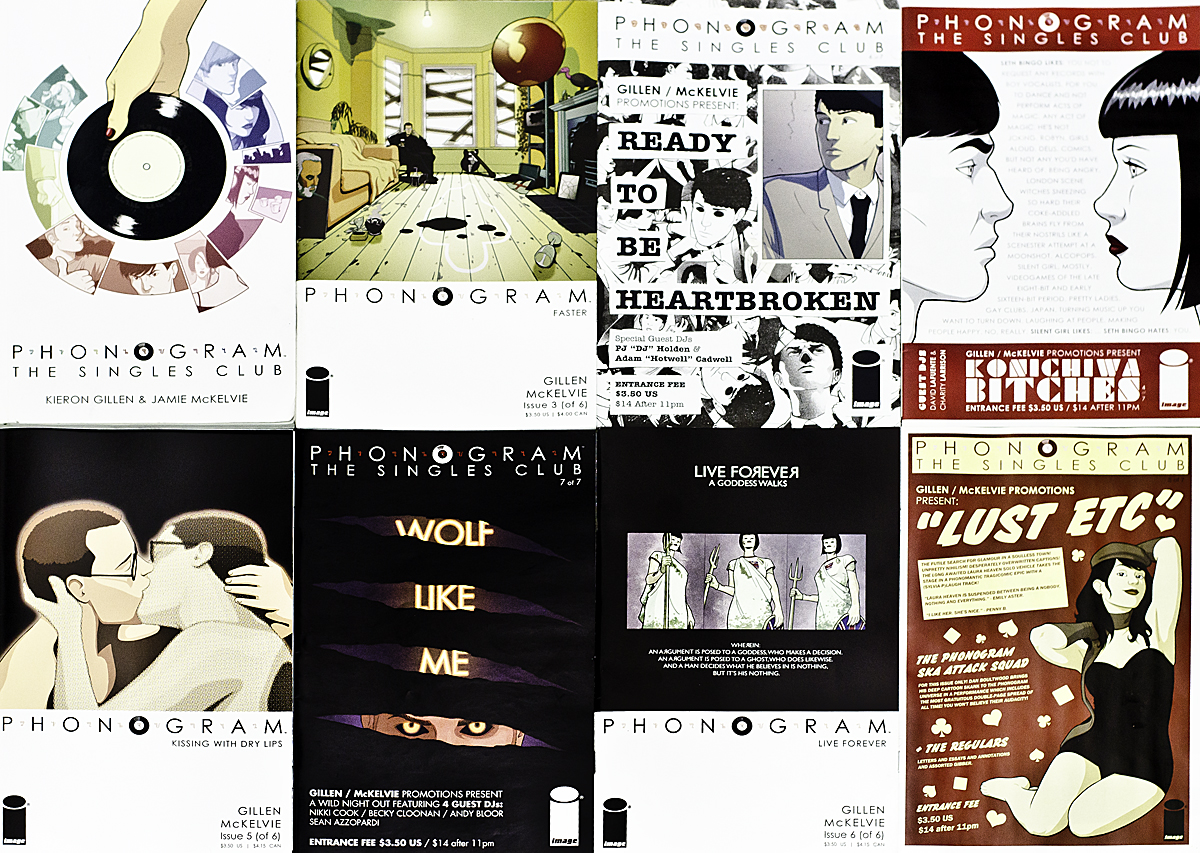I’ve been waiting to write about Phonogram. There are so many rock and roll comics to cover, so many different books with different approaches, and this one looms large. Kieron Gillen and Jamie McKelvie’s series is, in my mind, the ultimate encapsulation of the music/comics crossover, and I’ve put off discussing it for exactly that reason. I’ve been concerned about historical context, about proper chronology, the build-up… Except that’s kind of silly. We can talk about other things later, and fill in around the edges as we need to. For now, let’s face the music (and dance). Ladies and gentlemen:
Phonogram volume one is inspiring, but to be fair, a bit clunky. As the first major work by both of its creators, it bears all the straining ambition and brilliant flashes of that pedigree. “Music Is Magic” is the story’s core conceit: sorcery and pop songs woven together, references and song titles filling in every corner. Stark figures populate the panels, carefully posed cut-outs inhabiting a britpop shadowland. Thin ink lines chisel expressions and landscapes. Lyrics litter the dialogue, the writing striving (and often succeeding) to use print to express the thrill of sound. It leans on the works of others for emotional impact, but that’s natural, even fitting– after all, every band starts out playing covers. There are sparks of inspiration, stretches of pure unchecked splendor, and the occasional rough patches are barreled through without much concern. You see the creators learning their instruments as they go, and you feel all the thrill and uncertainty of a first moment onstage.
Phonogram: The Singles Club is a whole different ballgame. Originally released as seven stand-alone-yet-tied-together issues (and now collected in paperback), it takes all the clever bits and potential of the first series and shoots them into orbit. From the first page of the first issue, it’s clear that things have changed; everything that was good before is turned up to greatness. The paper stock has gone from matte to glossy, the palette from black and white to a world of carefully muted color. Jamie McKelvie’s artwork is a revelation, streamlined and multi-dimensional, each character and setting clearly defined with a few strokes. Likewise, Kieron Gillen’s writing is remarkable. The series takes place over one short evening; the text deftly juggles timelines and characters, moments echo from issue to issue. Events are seen from different perspectives as the cast moves along, hearing the same songs at the same club, crossing paths constantly. The Pipettes and Johnny Boy and The Supremes and CSS are each played only once, but those instants come at different points in each person’s night. Characters disappear in the background, then become the focus of the next chapter. And the noise builds– perspectives shifting, looping and scattering and repeating, adding dimension and depth with each character’s turn in the spotlight. The story and the pictures reinforce each other to build off the first series and expand in every direction. A world once posed is now captured in motion, speakers booming, bodies dancing, hearts breaking, eyes and hands raising to the skies in shared euphoria.
Phonogram isn’t only a comic book about music. It captures music itself: how we use it as emotional support, as distraction, as disguise, as catharsis. It’s a reminder of how deeply sound affects us. It’s how we feel when we hear our favorite songs.
Phonogram series one is available in trade paperback as “Phonogram: Rue Britannia“, series two is available in tpb as “Phonogram: The Singles Club“. Both are published by Image Comics. The original issues contain extra short stories and text pieces not included in the collected editions, and are therefore worth seeking out at your local comic shop (or on eBay if need be).
All articles in the Pop Music Comics series can be found here.


3 comments for “Pop Music Comics: Phonogram”